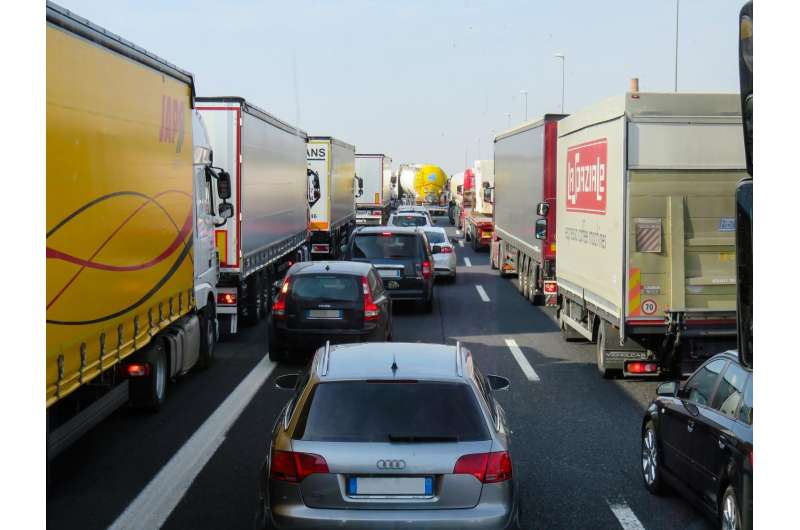Road traffic makes up one-fifth of the EU’s total CO2 emissions. Credit: Pixabay/ Gellinger
Linking up empty trucks and competing businesses through trusted networks could mean less road traffic and pollution.
Road traffic makes up one-fifth of the EU's total emissions of carbon dioxide while at the same time about one in five trucks on European roads is running empty — having already made a delivery or on the way to collect goods.
In a quest for more efficient use of our roads, researchers are piloting collaborative networks to connect producers, wholesalers and retailers in order to reduce emissions, fuel waste and costs, as well as traffic congestion.
The EU-funded NEXTRUST project is piloting schemes to identify vehicles that are not full and share similar routes with different businesses. By matching demand and capacity, shared networks can consolidate loads and cut down on unnecessary parallel trips.
The system, which functions through a trusted network arrangement, means trucks can be shared efficiently — without falling foul of competition regulations.
At its heart is a neutral hub, collecting data and facilitating the process of matching up users that could share trucks. This would cut costs for businesses and optimise the use of our roads. It could also be used to consolidate and move shipments onto rail and waterways.
Trust
By working in a trusted network that protects confidential information, the trustee system allows for the exchange of non-commercially sensitive data between partners, and prevents sensitive information leaking between them. That keeps participants on the right side of EU rules against market abuse.
Mike Bogen, of Dutch-based logistics information services firm Giventis International, who coordinates some of NEXTRUST's pilot schemes, said the principle was that participants were 'building trusted networks bottom-up, with like-minded partners, who share the same values and are open for collaboration, even with competitors'.
The crucial thing for NEXTRUST was to make certain that everything was in compliance with European competition law.
'This ensures that a collaborative network meets all the regulatory requirements, while maintaining a long-term, sustainable relationship between the partners on a flexible, community basis.'
The project, which runs till late next year, is piloting schemes intended to reduce deliveries by between 20–40 %, as well as cut greenhouse gas emissions by 40–70 %.
'We think these rather aggressive goals can be achieved by implementing the trusted networks business model,' Bogen said. 'And this is something that can be adopted in a widespread way across the market.'
Pilot schemes include moving goods from suppliers to retailers, as well as from retailers to consumers. They include Europe's construction and DIY sector, fresh and frozen food markets, and electronic goods.
While NEXTRUST looks at reducing emissions from a digital perspective, some EU-funded researchers are working to improve delivery trucks themselves, right down to the tyres that carry them down the highway.
Tyres
Energy management, aerodynamics and reducing drag all offer scope for reducing harmful transport emissions.
The EU-funded LORRY project, coordinated by tyre company Goodyear, focused on reducing rolling resistance, which is the friction the rubber experiences when the wheel turns on the road.
Rolling resistance usually accounts for about a quarter of fuel used and in some cases overcoming it can demand as much as a third of a truck's fuel consumption, so the pressure is on to make improvements.
By tweaking the tread pattern and tyre composition, LORRY researchers achieved substantial reductions in rolling resistance and wear, and improved performance in wet conditions.
LORRY coordinator Dr Benoit Duez, of Goodyear in Luxembourg, said: 'The normal fillers in a truck tyre are silica and carbon black, so we changed the kind of carbon black we used and also studied the possibility of using carbon nanotubes in the mix.'
The researchers also changed the tread pattern to improve the wear on the tyre and ensure grip is maintained even as the tyre tread wears away over time.
'This means that given wear on the tyre, new grooves will appear over time,' Dr Duez said. 'So the tread will always continue to release water and the tread will maintain the wet grip over the lifetime of the tyre.'
The researchers kept making improvements through a sequence of seven different combinations of tread and composition.
'It may have been possible to reduce rolling resistance a bit more, but there is always a compromise, because we also had to ensure safety,' Dr Duez said.
Some of the LORRY innovations are already being incorporated into Goodyear products, and Dr Duez sees wide scope for the technology in future – not just for reducing the carbon footprint of trucks, but also for passenger cars.
'Reducing greenhouse gases is one of the key issues for Europe so this project is of key importance,' he said.
Provided by Horizon: The EU Research & Innovation Magazine
























